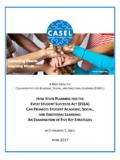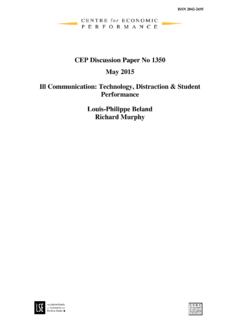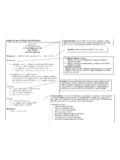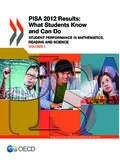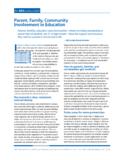Transcription of Student satisfaction and persistence: factors vital to ...
1 Research in Higher Education Journal Student satisfaction and persistence , Page 1 Student satisfaction and persistence : factors vital to Student retention Jalynn Roberts, The University of Southern Mississippi Ronald Styron, Jr., The University of Southern Mississippi Abstract The purpose of this study was to investigate students perceptions of services, interactions, and experiences in the College of Education and Psychology at a research-intensive university located in the southern region of the United States. Data were collected relative to participants perceptions for university experiences and services. The constructs included academic advising, social connectedness, involvement and engagement, faculty and staff approachability, business procedures, learning experiences, and Student support services. The results of the study indicated that students who did not return for the Fall 2008 semester or changed majors to another area had statistically significant lower perceptions of social connectedness and satisfaction with faculty approachability than students who returned.
2 Keywords: retention, persistence , Student , satisfaction , involvement, experiences Research in Higher Education Journal Student satisfaction and persistence , Page 2 Introduction Many students who endeavor to earn a college degree fail to persist until graduation. Although institutions have responded to Student retention issues by implementing programs and services, retention rates have not improved (Seidman, 2005a). The typical six-year graduation rate for most public institutions in the United States ranges between 50 56% (Berkner, He & Cataldi, 2002; Crosling, Thomas, & Heagney, 2008; Mortenson, 2005). Low retention rates not only impact students and institutions that must bear the economic burden connected to premature departures, but also the ability of a nation to compete in a global economy (Friedman, 2005; Seidman, p. xi, 2005a). Now more than ever, higher education administrators must be cognizant of the reasons why students depart from institutions of higher learning prematurely and what can be done to help students overcome these barriers so they can achieve their academic and career goals.
3 Additional research is required to determine strategies to address this issue (Tinto, 2005). Related Literature Ways of Measuring Retention Many methods and formulas assume a dichotomous, institution-based retention either students stay at an institution or they do not. However, retention can be viewed from multiple perspectives and is not always measured by whether or not a Student remains at a particular institution. Hagedorn (2005) has delineated four types of retention: institutional, system, academic discipline, and by course. Institutional retention is the most widely used method employed by colleges and universities. It is a calculation of the percentage of students who return to the same institution year after year. System retention consists of tracking students and not the institution in which the Student is enrolled. This means a Student who leaves one college but enrolls at another and completes his studies there is considered retained in the system of higher education.
4 This method of retention is very difficult to measure because it requires students to be tracked and is also costly. Retention within an academic major is focused on in retention within a specific academic discipline. Under this method, a Student who begins college as an English major and changes his major to mathematics would not be considered retained. While this type of retention is not uncommon among institutions or colleges within those institutions, these measures are not nationally tracked. Retention may also be measured at the individual course level. Measuring retention for individual courses informs college officials of those classes with low levels of Student retention even though students who had left the course may still be enrolled at the institution. This method of measuring retention is more complicated than one would assume because one must decide the number of class sessions necessary to constitute retention.
5 Simply put, it is difficult to define all Student enrollment actions as either retained or not retained. Current retention formulas usually exclude part-time students , transfer students , and returning students . Furthermore, universities can be somewhat flexible in determining which students can be counted in current retention measures and results can be somewhat inflated (Hagedorn, 2005). Research in Higher Education Journal Student satisfaction and persistence , Page 3 Academic Advising Perhaps the most crucial aspect of a Student s interaction and engagement with an institution of higher learning is the relationship with his/her advisor. Academic advising should be a process in which faculty and staff interact with students as they develop, allowing and helping them realize what decisions should be made and subsequent actions taken to achieve their educational and career goals. Pascarella and Terenzini (2005) purport that academic advising plays a role in students decisions to persist and also affects their chances of graduating.
6 Many students who depart prematurely from college often state a poor academic advising experience, and one of the main components of any retention program is an excellent advising program (Tuttle, 2000). Academic advising is much more than just scheduling courses and registering students for classes. Consequently, students take their relationships with their academic advisors very seriously, as they should. Furthermore, academic advising might possibly be, as Hunter and White (2004) suggest, the only organized and structured attempts in which university faculty or staff have sustained interactions with students . When one considers the mentoring and counseling aspect of academic advising, it becomes obvious that helping students realize their purpose in higher education and why they are pursuing their current educational goals do not simply occur in one or two visits; hence, academic advising is a process that occurs over time with students building relationships with their advisors.
7 Williams, Glenn, and Wider (2008) elaborate on the benefits of these types of relationships stating This relationship can improve the Student matriculation processes and provides students with a sense of security. The relationship also provides a sense of connectedness where students feel that they belong to the school and that the school belongs to them ( ). Social Connectedness One important factor which affects college students persistence is that of being socially integrated and connected with others, especially other students . College, for most students , is not only a time of academic pursuits but also an opportunity to explore or enhance themselves as social beings. Colleges should not present a barrier to this process. In fact, while some students desire to finish college, they do not consider themselves to be ultra-academic beings and instead want to partake in endeavors that develop them socially (Moxley, Najor-Durack, & Dumbrigue, 2001).
8 While there is no doubt that the degree of social integration varies from Student to Student , Bean (2005) states, Few would deny that the social lives of students in college and their exchanges with others inside and outside the institution are important in retention decisions (p. 227). Indeed, like most other challenges in life, a person is more likely to accomplish difficult tasks when he/she is in the company of others who are like-minded and facing similar challenges. Since a major part of the college experience is how well the Student adapts to unfamiliar surroundings and new people, the same holds true when a Student attends college. In fact, Kuh and Love (2000) claim that social integration consists of students social and psychological comfort with their institutions surroundings, associations with common groups of students , and a sense of belonging to the institution. These factors provide security which is needed to help students bond with other students to achieve common goals, one of the most important being to persist until graduation.
9 Research in Higher Education Journal Student satisfaction and persistence , Page 4 Involvement and Engagement students feel marginalized when they believe they do not fit it in, which leads to negative outcomes such as self-consciousness, irritability, and depression (Evans, Forney & Guido-DiBrito, 1998, p. 27). This feeling of marginalization causes students to wonder if they matter. Addressing this issue is important to Student retention as it is an antecedent to Student involvement in college activities and programs (Schlossberg, 1989). The most important step to becoming engaged and involved is for students to interact with their peers. According to Schlossberg, students interacting with their peers is a requirement that must occur in order to make participation in campus activities and Student organizations meaningful. However, the most important interactions with peers seem to reinforce the academic learning that takes place in the classrooms, and then the benefits of those interactions permeate into other areas of college life (Pascarella & Terenzini, 2005).
10 Whereas students must experience academic success to remain in college, it is also vital that they become involved and engaged in other areas of college life. students who do not become socially integrated may or may not suffer from persistence issues, as it largely depends on the individual. Therefore, failing to become involved in campus activities, organizations, and extracurricular activities, which promote involvement and integration of college life, can lead to higher chances of attrition for some students . Consequently, it is imperative for higher education administrators to work diligently to provide students with opportunities to get involved with campus organizations and activities (Tinto, 1993). Faculty and Staff Approachability Most scholars agree that the relationships between students and faculty are vital to Student success in college (Kuh, Kinzie, Schuh, Whitt, & Associates, 2005) and one of the principal aspects of facilitating these relationships includes faculty approachability.











